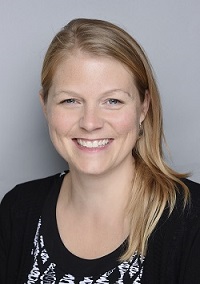November 2018 Featured Educator: Krista McInnis

How did you get to be a teacher in Dubai? What was your career path leading to that?
I finished my Bachelor of Arts degree and then didn’t know what I wanted to do, so I found myself at a language school in South Korea for three years. I liked it and decided to go back and get my teaching degree. Once I got my teaching degree, I had plans to go back to Korea actually, but then I met my husband. We had a family and decided to wait for our kids to be just a little older. They were three and five when we left Canada. We did two years in Doha and this is our eighth year in Dubai. I love the overseas, international life.
What is your school like? What kind of makeup of students and that sort of thing?
Our school is large and very diverse. Right now we have about 1,500 students from all over the world and have between 70 and 80 different languages. It’s an International Baccalaureate (IB) Curriculum. Under the umbrella of IB, there are three different programs for the different ages. We have the Primary Year Program (PYP), which is pre-K to Grades 5, then the Middle Years Program (MYP), from Grades 6 to 10, and then the DP, Diploma Program, which is Grades 11 and 12. I currently am working in the MYP, specifically with Grades 7, 8, and 9, but I was in the PYP earlier.
The students have a lot of different language backgrounds. Are all the classes taught in English?
All the classes are taught in English. It is mandated by the UAE government that every student take Arabic class. In the MYP they also have to take French or Spanish. If you have a student coming in already with two or three languages, now you add Arabic, plus either English, French, or Spanish. It’s a lot.
How does WIDA help you with some of that language instruction? Do you use the abbreviated WIDA MODEL? What do you use for that identification?
Initially, when a family wants to enroll their child in this school, the school does a quick assessment using MAP (NWEA Measures of Academic Progress). We use MAP as the initial screening for all students, regardless of language. If something is flagged, for example, if there’s a combination of their native language plus a very low reading or language usage score, it would just raise a red flag that the EAL teacher needs to take another look at this student and then we would use the full WIDA MODEL to identify them as an EAL student. EAL means English as an Additional Language. If they’re identified as an EAL student, they will not take Spanish or French. They will instead go into an EAL support class. We use WIDA MODEL to place them.
Since it’s not a teacher who does the initial screening, we’re trying to get those people in admissions trained in the WIDA screening so that we can speed the process up and get the students identified earlier, before they actually join a class. That’s one of our goals, to get the Screener in place.
Once you get them in place, what types of instruction do you use with the students that help them with their language development?
It’s an EAL pullout support class and by that I mean we’re supporting their English language development, but we’re also supporting the content that they’re getting from their other classes. We use WIDA MODEL to find out what skills and abilities they need for English, to improve upon.
Then we also have collaboration time with the content teacher. For example, I will work with the science teacher. I know what’s coming up in a unit and am able to then create materials, look for visuals, look for audio, create vocabulary charts, and bring it into my EAL pull-out class. That way the students get a little bit of a preview before a lesson in their content area or maybe even a review of what they’re getting in their content area. It’s looking at exactly what the students need and giving what they need, and at the same helping them with that content. It’s really, really intense for them. It’s a lot of technical, specific vocabulary. There’s a lot on their plate, so it really is an EAL support class.
For those co-teaching opportunities, do you use things like WIDA Can Do Descriptors?
Yes. Absolutely. When the full WIDA MODEL assessment has been done and we’ve placed a student in the right classes, then I become that student’s case manager. As the case manager, it’s my job to communicate to the content teachers what WIDA is, what the scores actually mean, use the Can Do Descriptors so that they’re actually able to say, “The student can do this, so I’m going to ask them to do that,” just to try to and get them stretched a little bit to improve their language development.
Do you find you have enough resources from WIDA to do this?
I really do. Once the content teachers have learned what WIDA offers, and what those scores mean, then we’re talking the same language. I can talk with a teacher and say, yes, she’s writing at a 2.2 and this is what she’s able to do. We can discuss what we can do to provide for the student. It’s that common language that really bridges the communication gap that existed before.
Tell me about your students. How do you get them motivated? How do you encourage them to move up, like you said, from one language level to another?
It’s interesting that you ask that question right now, because I’ve been doing something a little different this past month that has gotten a good reaction from them. I print their WIDA individual report page, and as a class, we sit down together. Everybody has their own report in front of them--they don’t need to share it with one another. I ask them to identify their strengths, areas they think they want to improve on, and what their levels mean. I ask them to think really explicitly about what this means, the reason they took the test and what we can do with that information. I just did it today with my Grade 9 class and an amazing conversation came out of talking about it. “Oh, wow! My reading and my listening skills are a lot higher than my speaking and my writing skills.” I pushed that further along by asking why they thought that was the case, and the response was, “Well, I have to make up those words myself.” It was a really good conversation to get them in line with the idea of goal setting.
Today, from our conversation, because they’re all about the same level, they more or less came up with a group goal that, if I want to move from a 4 to a 5, I really need to learn how to write better sentences or a variety of sentences. That led us right into a lesson of dependent and independent clauses. They were really excited to get going on this because they were driven by improvement.
Are there any other tools that you use in your school to help English language learners?
We have a designated collaboration time with content and language teachers. We also have some Response to Intervention time where teachers can sit together in departments and bring up ideas about proficiencies of students and what is in their toolkit, what else we can do. There are a lot of brainstorming sessions for different strategies. We use our MAP data for reading and language usage in combination with their WIDA scores.
Is there anything else you’d like me to know about you, your school, your students, the community you’re in?
It’s very unique. It’s even unique for international schools. I’ve visited a lot of international schools and you get a lot of schools that are made up of primarily a passport country. This school is unique in that we’re from everywhere and there are so many different languages. When a student comes in and is tested for English, there’s a reason why we say E-A-L and not E-S-L. Truly we’re teaching two and three languages, so I find that I’m fortunate to see the students that I do, because they just have so many different languages. On top of that, I find that they are almost more confident, being proud of their native languages. They might have two or three of those. There’s just a lot of conversation happening around language, which I think is exciting and maybe they don’t get everywhere else.





